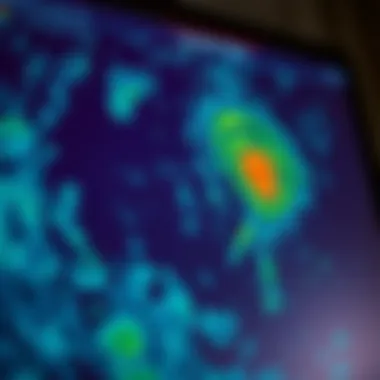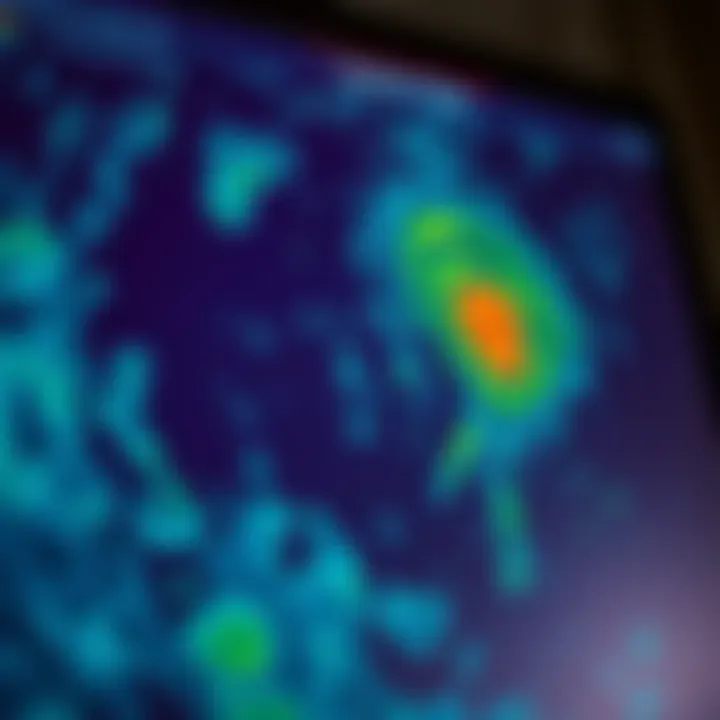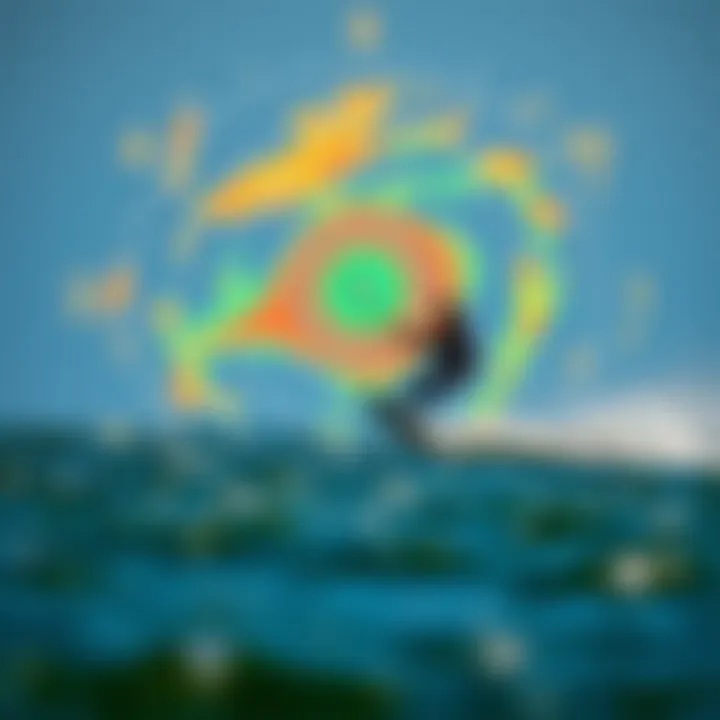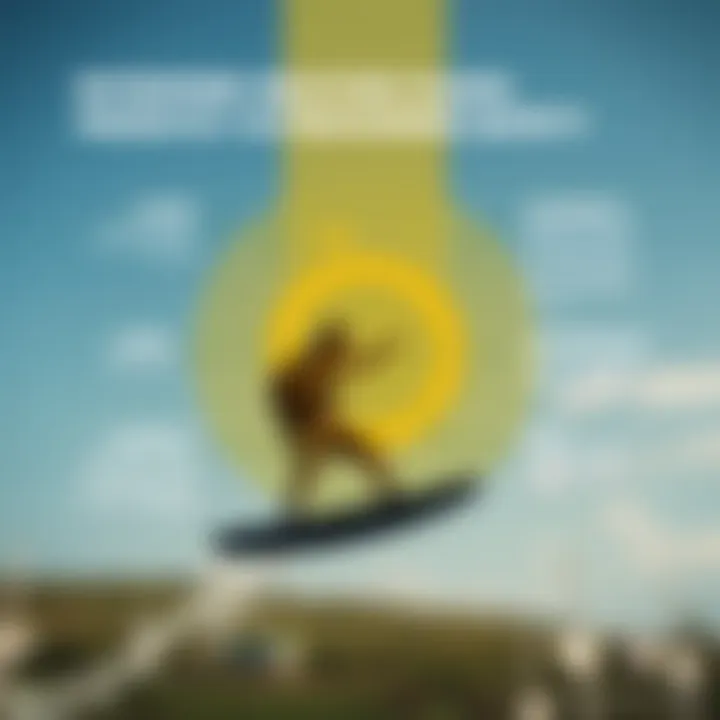Exploring Weather Radar Insights for Kiteboarding in Willmar


Intro
Weather radar plays a significant role in understanding the atmospheric conditions that affect various outdoor activities, especially for kiteboarding enthusiasts in Willmar, Minnesota. This guide digs into how radar technology works, the unique weather patterns evident in this part of the state, and why comprehending such information is crucial for both seasoned and novice kiteboarders.
Through examining specific radar data and insights, we aim to elevate the kiteboarding experience while ensuring safety remains a top priority. The landscape of Willmar, with its lakes and open spaces, presents unique challenges and opportunities for kiteboarding.
Kiteboarders in this region often battle unpredictable weather patterns. Hence, getting to grips with weather radar can be a game changer. From interpreting radar images to understanding the implications of approaching storm systems or wind shifts, this information can assist in making informed decisions while out on the water.
Overview of Weather Radar Technology
Weather radar technology plays a crucial role in our ability to understand and interpret changing weather conditions. For kiteboarders and outdoor enthusiasts in Willmar, MN, having accurate weather data can mean the difference between a thrilling experience and a dangerous outing. The weather here can shift gears quicker than a speeding train, and being clued into radar insights can help adventures unfold smoothly.
Principles of Weather Radar
At its core, weather radar operates on the principles of transmitting radio waves and analyzing their reflections from precipitation particles. The radar emits bursts of energy, capturing the echoes that bounce back from rain, snow, hail, or even dust. The time it takes for the signal to return helps meteorologists determine the distance to the weather phenomenon. Meanwhile, understanding how intense the return signal is points to the strength of the storm or precipitation.
This principle goes beyond just spotting rain; it encompasses a broad range of weather events, including severe storms and possible hazardous conditions. Therefore, having a grip on these fundamental principles means that kiteboarders can make informed decisions about when to hit the water and when to stay on dry land.
Types of Weather Radars
In the world of meteorology, there are several radar types, each with its strengths. Below are the main types relevant to weather tracking in Willmar:
Pulse-Doppler Radar
Pulse-Doppler radar is a game-changer when it comes to tracking the motion of storms. What sets it apart is its ability to differentiate between moving objects and stationary targets. This means it can measure wind speed, which is vital for someone looking to kiteboard. Wind speed and direction can change like the flick of a switch, so having that reliable information helps in both forecasting and avoiding bigger storms.
The major advantage is that it gives real-time updates, allowing kiteboarders to plan their outings with precision. However, it can struggle near terrain or other obstacles, leading to blind spots that could misguide a user.
Frequency-Modulated Continuous Wave Radar
Another fascinating technology is Frequency-Modulated Continuous Wave radar, or FMCW radar. It operates by sending out continuous signals that vary in frequency. This method provides enhanced accuracy when measuring smaller objects, such as raindrops. Its ability to maintain a constant watch can help kiteboarders gage even slight changes in weather conditions.
A key benefit of this radar is that it can deliver high-resolution images of precipitation that might be ignored by other types. Of course, the technical requirements can be more demanding which may limit its deployment in certain areas.
Dual-Polarization Radar
Dual-polarization radar is essentially the Swiss Army knife of radars, offering substantial improvements in detecting precipitation type and intensity. By transmitting in both horizontal and vertical orientations, it can provide a clearer picture of the weather. This is particularly important in discerning between rain and snow, allowing kiteboarders to avoid cold winter storms that can be deceptive.
One of the unique features is its capability to analyze precipitation structure and moisture content, which can significantly enhance safety. However, the complexity of this technology can require more sophisticated interpretation, meaning there might be a learning curve for those trying to maximize its use.
Importance of Radar Technology
The overarching importance of radar technology cannot be understated in regions like Willmar. This technology enables accurate forecasting, making sure that kiteboarders can enjoy their time on the water while mitigating risk. From assessing changes in wind patterns to predicting severe storms, radar plays a pivotal role. It empowers users with not just data, but actionable insights that can keep situations from turning dire. As such, understanding radar technology is essential for anyone wanting to optimize their kiteboarding experience.
Weather Patterns in Willmar, MN
Understanding the unique weather patterns in Willmar, MN is essential for kiteboarders aiming for a successful outing. Weather not only influences leisure activities but also plays a significant role in safety measures. Grasping the seasonal nuances helps kiteboarders to navigate the skies and the waters with confidence and awareness. In this section, we will examine the seasonal weather characteristics, the microclimates, and how these elements shape the kiteboarding experience.
Seasonal Weather Characteristics
Winter Weather Trends


Winter in Willmar is marked by its cold temperatures and snowfall, with December often bringing the season’s first significant snow. The key characteristic to note here is the unpredictable nature of winter storms. A seemingly tranquil day can quickly morph into a fierce sight, with sudden blizzards disrupting outdoor activities. For kiteboarders, late winter can offer thrilling opportunities when ice forms on the lakes, allowing for unique sessions. However, the slippery conditions pose risks, necessitating caution and preparation, making it a beneficial yet challenging period for enthusiasts.
Spring Storm Dynamics
As spring rolls in, the winds begin to pick up, birthing a dance of storm dynamics that are important for kiteboarders to understand. Thunderstorms are commonplace, often developing rapidly and bringing strong gusts. This shifting weather can be both exciting and perilous. A highlight of spring storms is the formation of microbursts—intense downdrafts that can catch even seasoned kiteboarders off-guard. Understanding these dynamics can greatly improve safety and enjoyment, making it a topic of particular relevance for our kiteboarding community.
Summer Heat and Storms
Summer ushers in heat and often leads to sudden thunderstorms. The high temperatures can create unstable atmospheres, leading to severe weather systems. This festive season can be enticing for kiteboarders, offering excellent conditions on calm days. However, the key feature here is about learning to balance fun with vigilance, as storms can erupt unexpectedly. It's beneficial to keep an eye on any radar images, so you are not caught unawares. Knowing how to check and interpret the changing conditions can turn a good day into a great one.
Autumn Weather Shifts
Autumn presents a different charm, as temperatures begin to cool, leading to clearer skies and consistent winds. This season stands out because it can showcase quite stable weather patterns, perfect for kiteboarding. The striking colors of fall against the backdrop of clear day can be spectacular, making it an appealing time to hit the water. Yet, the cooler temperatures can be a double-edged sword—while the winds are more predictable, the cold can deter some from venturing out. Nevertheless, for those who choose to embrace the chills, autumn offers rich rewards.
Microclimates in Willmar Area
The landscape of Willmar features various microclimates influenced by local geography. Lakes and the surrounding areas create pockets of weather that can differ from neighboring locations. These microclimates can affect wind patterns and temperature, which are vital for kiteboarders to consider. For example, conditions near the lakes can be calmer due to the water's moderating effect compared to the more open fields on the outskirts. By paying attention to these variations, kiteboarders can pinpoint the most favorable spots for launching and riding.
Interpreting Weather Radar Data
Interpreting weather radar data is essential for understanding local weather conditions, especially for kiteboarders in Willmar, MN. Analyzing radar images aids in anticipating weather patterns, which can drastically improve both safety and enjoyment on the water. The nuances of radar interpretation not only streamline decision-making but also furnish enthusiasts with the confidence to navigate changing conditions.
Reading Radar Images
When one first glances at a radar image, it may come across as a jumbled mess of colors and shapes, but there’s a method to the madness. Each hue represents different precipitation intensity, ranging from light showers to severe storms. In the context of kiteboarding, it’s crucial to quickly distinguish areas of safe sailing from those announcing tumultuous winds and rain. For example, brighter shades of yellow or red often signal heavier rainfall, while light green indicates gentle drizzle.
A clear understanding of these color coding schemes can mean the difference between an exhilarating ride and a treacherous one. Kiteboarders should familiarize themselves with the interpretation of these visuals through practice. Regularly checking local radar images, like those available from the National Weather Service, can bolster knowledge and confidence over time.
The Role of Reflectivity
Reflectivity is a term you might hear often in meteorological circles. It essentially measures how much radar energy is bounced back from droplets of water in the atmosphere. High reflectivity suggests a higher density of moisture or precipitation, indicating likely heavy rain and potential hazards. Conversely, lower reflectivity often suggests clear conditions or light precipitation.
For a kiteboarder, being attuned to reflectivity measurements can reveal much about upcoming weather trends. If the reflectivity suddenly spikes, it could signal incoming storms, suggesting that it's time to pack up or seek shelter.
"Understanding reflectivity is like having a weather crystal ball, helping you foresee and avoid storms before they take you by surprise."
Velocity and Motion Analysis
Another crucial aspect of radar interpretation involves velocity and motion analysis. This aspect sheds light on storm movement and wind patterns, something extremely pertinent to kiteboarders. Velocity data indicates how fast precipitation particles are moving toward or away from the radar, which can help predict storm paths. For kiteboarding enthusiasts, knowing the wind direction and speed can mean the difference between a joyful glide over calm waters and a dangerous tussle against strong gusts.
By incorporating velocity analysis into pre-kiteboarding checks, one can easily monitor how quickly storm systems advance and where they’re likely headed. It's prudent to stay updated on these metrics, especially as they relate to local weather patterns. Keeping an eye on this data will allow kiteboarders to plan their outings smarter and safer.
Practical Applications for Kiteboarding
Kiteboarding, an activity that melds the thrill of surfing with the artistry of flying, relies heavily on accurate weather predictions. The practical applications of weather radar in this sport emphasize how crucial it is to understand conditions before hitting the water. Weather radar offers insights that can make the difference between a fun, safe adventure and a risky situation. The data derived from weather systems can determine the safety of a kiteboarding outing, help in planning the best time to hit the waves, and ultimately contribute to an exhilarating experience to enjoy the sport to its fullest.
Importance of Weather Monitoring
Monitoring weather patterns is paramount in kiteboarding. Conditions that seem inviting can quickly turn troublesome. For instance, an unexpected squall can emerge, leaving kiteboarders unprepared. Therefore, keeping an eye on the weather radar helps enthusiasts avoid such dangerous situations. By understanding wind shifts and storm formations, kiteboarders can make informed decisions about their outings. Weather radars can detect precipitation, wind speed, and direction, allowing kiteboarders to plan their sessions effectively and stay alert to changing conditions.
Utilizing Weather Data for Safe Kiteboarding
Safe kiteboarding hinges on the ability to interpret the wealth of information that radars provide. Kiteboarders can leverage this data to enhance their safety protocols. By staying updated with real-time weather data from local radar sources, they can track wind patterns and changes that occur throughout the day. For example, if radar shows increasing wind intensity, kitesurfers might decide to shorten their session or come down altogether. Knowledge is power, and in the context of kiteboarding, it can mean the difference between a thrilling experience and a potentially dangerous scenario. Such utilization of weather data can transform a regular outing into a well-informed adventure.


Best Practices for Kiteboarders
Checking Radar Before Outings
Before venturing out, kiteboarders should prioritize checking radar updates. This practice allows for a clear view of the current weather landscape and forecasts potential changes. The main characteristic of this step is its foresight. Being aware of approaching fronts or sudden wind shifts can prevent mishaps. It's a popular choice for seasoned kiteboarders who know that the wind can switch gears quicker than one can imagine. The unique feature of this practice lies in its simplicity - accessing radar apps or websites gives immediate feedback. This knowledge lets riders avoid conditions that could lead to accidents on the water.
Understanding Storm Alerts
Understanding storm alerts is another crucial aspect that kiteboarders should not take lightly. These alerts provide vital information about severe weather that could impact kiteboarding activities. The key here is responsiveness. When storm alerts are issued, kiteboarders must evaluate their plans and possibly postpone their sessions. This practice is beneficial as it prioritizes safety over thrill-seeking. The unique feature of storm alerts is their immediacy; they deliver real-time warnings that empower kiteboarders to make quick decisions. Ignoring these alerts can have dire consequences, so cultivating a habit of consulting storm warnings can save lives.
Analyzing Wind Patterns
Lastly, analyzing wind patterns is a skill that every kiteboarder should hone. Wind is the lifeblood of kiteboarding; understanding its rhythm helps in predicting when to ride. The distinctive aspect of this practice is its dynamic nature. Wind does not just blow; it ebbs and flows, and recognizing these patterns enables riders to catch optimal conditions. By examining radar data coupled with local reports, kiteboarders can assess the sustainability of the winds for their outing. This practice is beneficial, ensuring sessions are not only exciting but also safe.
"Successful kiteboarding requires not just the love for the waves, but also respect for the skies."
In summary, practical applications for kiteboarding shed light on how essential it is to harness weather radar data for enhancing the kiteboarding experience. Monitoring weather closely, utilizing available data, and adhering to best practices can facilitate safer riding and better informed decisions on the water.
Local Resources for Weather Information
When it comes to kiteboarding in Willmar, MN, understanding the local weather patterns is crucial. Reliable sources of weather information not only enhance the experience for enthusiasts but also significantly contribute to safety on the water. Utilizing a blend of local meteorological services and various online platforms ensures you’re equipped with timely data, making your kiteboarding trips smoother and more enjoyable.
Official Meteorological Services
Official meteorological services are the backbone of weather forecasting. They employ advanced technology and trained personnel to analyze climatic conditions in real-time. In Willmar, the National Weather Service offers insights that are scientifically backed and regularly updated. The data provided often includes temperature readings, wind speeds, storm warnings, and precipitation forecasts.
Having access to such information allows kiteboarders to plan their outings around favorable weather conditions. For example, the NWS issues alerts for severe weather, which can be a lifesaver if you're out on the water when conditions suddenly change. This resource is invaluable because it provides information that’s accurate and community-focused, considering local characteristics of the weather.
Online Weather Platforms
The rise of technology has made online weather platforms a go-to for many kiteboarding enthusiasts. These websites and apps, such as Weather.com and AccuWeather, offer user-friendly interfaces exhibiting real-time weather updates and radar images. They allow for a granular look at conditions specific to Willmar, which is beneficial when figuring out the best times to ride.
Local News Stations
Local news stations play a key role in disseminating weather information tailored to the Willmar area. Typically, they provide forecasts that are highly relevant to residents. One specific aspect of local news stations is that they often include human elements in their reports. In other words, in addition to data, viewers or readers receive real-life stories or visuals that connect the audience to the weather conditions. This can create a better understanding of how to respond to different weather scenarios.
A key characteristic that makes local stations a popular choice is their focus on community interests. They often cover weather in a way that directly affects the local population, including alerts for storms or advisories.
With platforms like KARE 11 or WCCO, you get localized content that’s timely and trustworthy. One unique feature is that many stations also provide social media updates or live streaming for immediate access to weather news. However, while these platforms offer extensive local insight, they may not always have the most advanced radar technology compared to official sources.
Community Forecast Services
Community forecast services can bridge the gap where other services fall short. They often rely on crowdsourced data and local expertise. This means that residents who are familiar with unique microclimates in Willmar contribute to the forecasts. Because they emphasize community interaction, you might find individuals providing updates on conditions as they happen.
A key characteristic of community forecast services is their accessibility – often, they are free to use and cater specifically to the needs of local kiteboarders. Local Facebook groups or community bulletin boards can serve as excellent resources for real-time weather stories and personal experiences.
While these services can provide valuable grassroots information, one must be cautious since they may not have rigorous verification processes, leading to occasional inaccuracies. Nonetheless, they can be highly beneficial for gauging conditions more subjectively and personally.
Forecasting Challenges in Willmar
In the ever-evolving world of weather forecasting, the challenges faced in Willmar, Minnesota, are both fascinating and complex. Local meteorologists and enthusiasts alike must navigate through a myriad of factors that can impact the accuracy of weather predictions. This section sheds light on significant hurdles and considerations that arise within the context of radar technology and forecasting techniques.


Common Limitations of Radar
Weather radar, while exceedingly beneficial, is not without its shortcomings. One of the primary limitations is its range; for instance, most radar systems can detect precipitation effectively within a certain radius but may struggle to provide reliable data beyond that distance. This limitation can be particularly problematic in an area like Willmar, where varying geographic features can distort radar signals. Additionally, radar is less effective in detecting light precipitation, which is a common occurrence in the spring months. Thus, radar may miss crucial data that could affect kiteboarding conditions, leading to unexpected challenges.
Regional Obstructions to Accuracy
Terrain Effects
The intricate topography of the Willmar area presents a unique challenge to accurate forecasting. With hills and valleys interspersed throughout, the reflection and scattering of radar signals can lead to gaps in data. Areas that might be receiving significant rainfall or wind could be falsely reported as clear skies if the radar cannot effectively penetrate through or reflect off these geographical features.
Key factors include:
- Elevation changes: Radar signals can be blocked, causing diminished accuracy in certain regions.
- Microclimates created by hills or forests can lead to localized weather patterns not captured by broader radar coverage.
These terrain effects suggest that while radar is a vital tool, it must be complemented with other forecasting methods to achieve a full picture.
Urban Development Influences
The rapid urban development in and around Willmar can also impede radar accuracy. New infrastructure alters the natural landscape, which can change how radar signals are interpreted. Buildings, roads, and other structures can create reflections and shadows that confuse radar readings, misleading forecasters about weather patterns. The growth of the city can lead to urban heat islands, where temperatures may not reflect typical trends found in surrounding rural areas. This characteristic of urban development presents a compelling reason for kiteboarders to remain vigilant.
Considerations of urban impacts include:
- Signal interference caused by towering buildings leading to potential blind spots in weather data.
- Alterations in local temperatures that may not align with traditional forecasts, influencing wind patterns crucial for successful kiteboarding.
Accurate weather forecasting is a blend of technology and nature, requiring an understanding of both radar limitations and the local environment.
Future Trends in Weather Radar Technology
The future of weather radar technology is a bright one, especially for regions like Willmar, MN, where weather can change quicker than you'd expect. The advances in technology are not just a fancy upgrade but play a crucial role in how accurately we can monitor and forecast weather, which is pivotal for activities like kiteboarding. Understanding these changes can mean the difference between a thrilling kiteboarding experience and a race against an incoming storm.
Advancements in Radar Systems
Recent efforts in radar technology have led to significant advancements that enhance the precision and reliability of meteorological predictions. One major improvement is the increased resolution of radar images. With higher resolution, meteorologists can detect smaller and more localized weather phenomena. This means that kiteboarders might get more precise information about wind shifts or storm cells a bit further away, allowing them to make informed decisions.
Moreover, modern weather radar systems are now capable of faster updates. Where updates might have previously taken several minutes, new systems can provide near real-time data. This technology offers an edge in rapidly shifting weather, something kiteboarders navigating across Willmar's waters should not overlook.
Integration with Other Technologies
The integration of radar systems with other technology sources is an exciting realm that enhances weather forecasting. By combining various datasets, forecasters can create a more comprehensive picture of the weather. This integration comes in two particularly noteworthy forms: satellite data and AI models.
Satellite Data
Satellite data is a powerful tool in weather forecasting. Unlike ground-based radars that provide a localized view, satellites give a broader perspective. They can monitor development over vast areas, which is essential for understanding large weather systems that might affect conditions in Willmar.
One key characteristic of satellite data is its ability to track temperature variations and precipitation patterns on a much larger scale, which provides insight into long-term weather trends. For kiteboarders, this means not only understanding day-to-day variations but also being able to anticipate seasonal changes to better plan outings.
However, there are some unique features to consider. Satellite data can be sometimes slow to respond to immediate changes in local weather patterns. If a storm is brewing, data captured a few minutes before might not be entirely relevant.
AI and Predictive Models
Artificial intelligence is revolutionizing the field of weather monitoring by offering predictive models that can generate forecasts based on vast datasets. These models analyze historical weather patterns and combine them with real-time radar data to enhance accuracy.
The main benefit of using AI in weather prediction lies in its ability to learn and adapt. As it processes more data, it gets better at interpreting weather changes. For kiteboarders, AI-driven predictions mean potentially avoiding storms or catching ideal wind conditions without needing to constantly check radar updates.
Nevertheless, depending too heavily on AI models can be a double-edged sword. There's a risk involved when relying solely on these systems, as any algorithm can misinterpret scenarios based on erroneous data inputs or unforeseen anomalies.
In summary, future trends in weather radar technology promise enhanced forecasting capabilities, improved safety measures, and a richer understanding of weather dynamics that profoundly impacts outdoor activities like kiteboarding.
These advancements will not only help enthusiasts stay safe but also empower users to seize the best conditions across Willmar's waterways.















